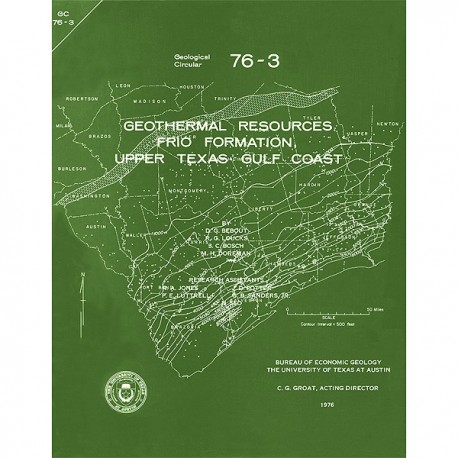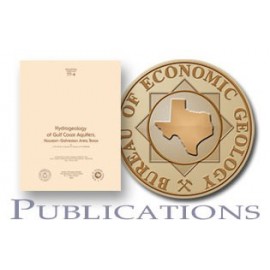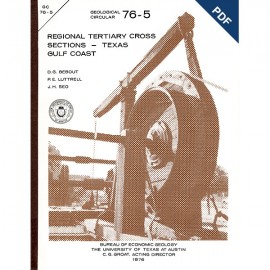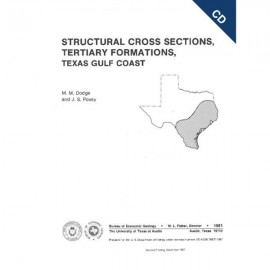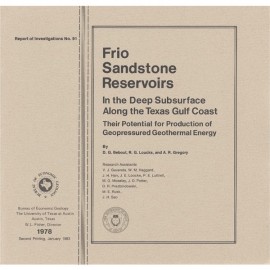Geological Circulars
-
Books & Reports
- Reports of Investigations
- Guidebooks
- Udden Series
- Geological Circulars
- Down To Earth
- Atlases of Major Oil and Gas Reservoirs
- Texas Memorial Museum Publications
- Environmental Geologic Atlas of the Texas Coastal Zone
- Mineral Resource Circulars
- Other Reports
- Seminars and Workshops
- Handbooks
- Submerged Lands of Texas
- Symposia
- Annual Reports
- Open File Reports
-
Maps & Cross Sections
- Thematic Maps
- Miscellaneous Maps, Charts & Sections
- Geologic Atlas of Texas
- STATEMAP Project Maps
- Geologic Quadrangle Maps
- Cross Sections
- Highway Geology Map
- Energy and Mineral Resource Maps
- Shoreline Change and Other Posters
- Wilcox Group, East Texas, Geological / Hydrological Folios
- Bouguer Gravity Atlas of Texas
- River Basin Regional Studies
- Featured Maps
- Posters
- Teachers & the Public
-
Geological Society Publications
- Gulf Coast Association of Geological Societies
- Alabama Geological Society
- Austin Geological Society
- Corpus Christi Geological Society
- Houston Geological Society
- Lafayette Geological Society
- Mississippi Geological Society
- New Orleans Geological Society
- South Texas Geological Society
- GCS SEPM Publications
- Historic BEG & UT Series
Geothermal Resources--Frio Formation, Upper Texas Gulf Coast
GC7603
A free, digital version of this publication can be found on: Texas ScholarWorks
GC7603. Geothermal Resources--Frio Formation, Upper Texas Gulf Coast, by D. G. Bebout, R. G. Loucks, S. C. Bosch, and M. H. Dorfman. 47 p., 52 figs., 1976. ISSN: 0082-3309. Print.
To purchase this publication as a PDF download, please order GC7603D.
ABSTRACT
The objective of this study is to identify major sand trends, which, along with subsurface temperatures and pressures, aid in evaluating the potential of producing geothermal energy from the Frio Formation, Upper Texas Gulf Coast.
During the Tertiary, huge quantities of terrigenous sediments were deposited as gulfward-thickening sedimentary wedges along the Texas Gulf Coast. The sand and shale making up these wedges were transported across a broad fluvial plain and deposited in deltaic complexes or were reworked by marine processes into strandplains and barrier islands. Growth faults developed contemporaneously at the site of maximum deposition as a result of rapid loading of large quantities of delfaic and strandplain sands onto previously deposited prodelta and shelf muds. These growth faults allowed the accumulation of extremely thick sections of sand and also caused the isolation of many of these sand bodies from porous updip sands; pressured reservoirs developed after further loading and compaction (Bruce, 1973; Jones, 1975).
This study is investigating geopressured geothermal reservoirs in this setting. Limited data obtained from deep wells drilled for oil and gas indicate that many of these large sand reservoirs are filled with water which has high temperature, is relatively low in total dissolved solids, and is saturated with methane gas. To be suitable for electric power generation, the reservoir should have a volume greater than 3 cubic miles (which is equivalent to 300 feet of sand distributed areally more than 50 square miles), permeability greater than 20 millidarcies, and subsurface temperatures higher than 300°F.
This report reviews the results of the Bureau of Economic Geology regional study of the Frio Formation in the Upper Texas Gulf Coast. It is a continuation of two similar studies of the Frio in the Lower and Middle Texas Gulf Coast (Bebout, Dorfman, and Agagu, 1975; Bebout, Agagu, and Dorfman, 1975). The objective of these reports is to outline areas (fairways) which appear the most prospective for producing geothermal energy and which therefore deserve further, more detailed study.
Keywords: geothermal energy, Frio Formation, Gulf Coast, Texas
Citation
Bebout, D. G., Loucks, R. G., Bosch, S. C., and Dorfman, M. H., 1976, Geothermal Resources--Frio Formation, Upper Texas Gulf Coast: The University of Texas at Austin, Bureau of Economic Geology, Geological Circular 76-3, 47 p.
